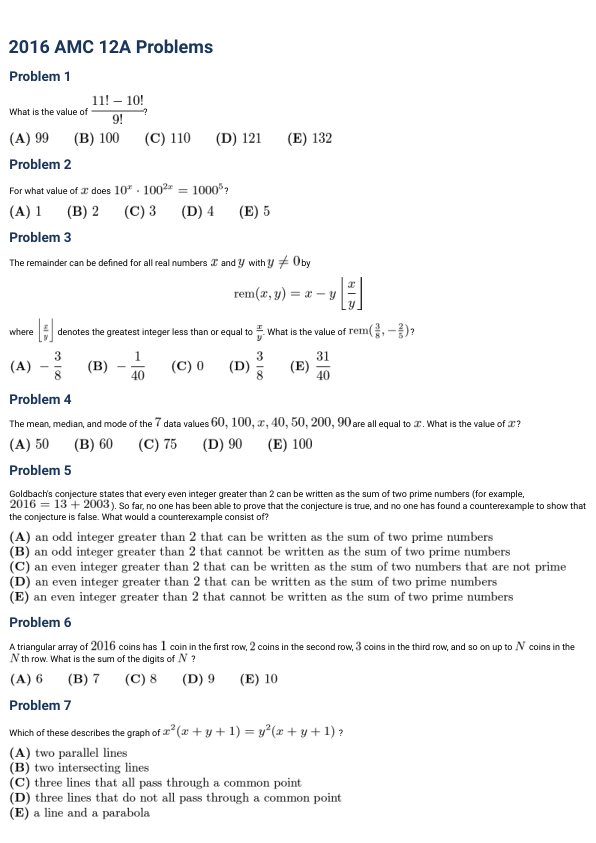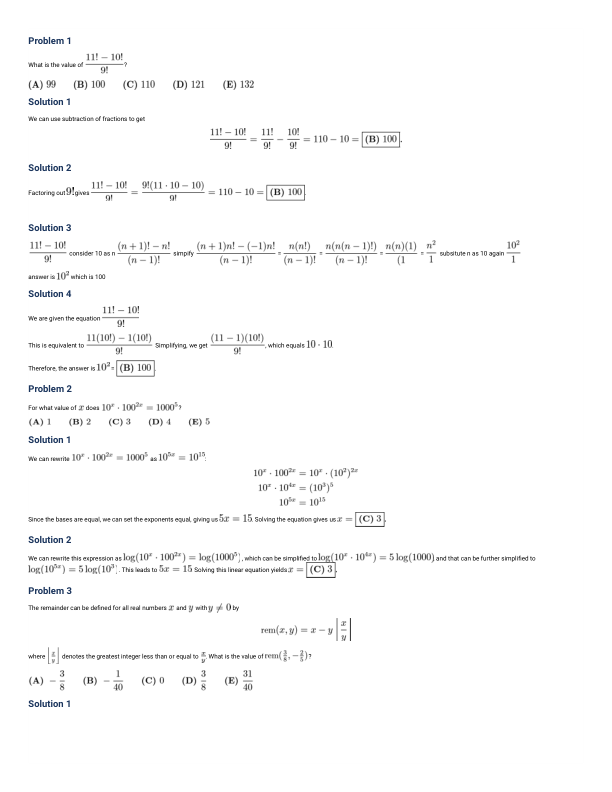2016 AMC amc12a 真题 答案 详解
| 序号 | 文件列表 | 说明 | ||
|---|---|---|---|---|
| 1 | 2016-amc12a-paper-eng-zh.pdf | 11 页 | 462.51KB | 中英双语真题 |
| 2 | 2016-amc12a-paper-eng.pdf | 4 页 | 238.68KB | 英文真题 |
| 3 | 2016-amc12a-key.pdf | 1 页 | 10.08KB | 真题答案 |
| 4 | 2016-amc12a-solution-eng.pdf | 33 页 | 2.96MB | 真题文字详解(英文) |
| 5 | 2016-amc12a-solution-eng-zh.pdf | 33 页 | 2.96MB | 真题文字详解(中英双语) |
| 6 | 2016-amc12a-solution-video-zh.mp4 | 22.66 分钟 | 53.02MB | 真题视频详解(普通话) |
中英双语真题
2016 AMC12A
Problem 1
What is the value of (\frac{11! - 10!}{9!})?
(\frac{11! - 10!}{9!}) 的值是多少?
(A) 99 (B) 100 (C) 110 (D) 121 (E) 132
Problem 2
For what value of (x) does (10^x \cdot 100^{2x} = 1000^5)?
(x) 的值为多少时,(10^x \cdot 100^{2x} = 1000^5)?
(A) 1 (B) 2 (C) 3 (D) 4 (E) 5
Problem 3
The remainder can be defined for all real numbers (x) and (y) with (y \neq 0) by
[ \text{rem}(x,y) = x - y \left\lfloor \frac{x}{y} \right\rfloor ]
where (\left\lfloor \frac{x}{y} \right\rfloor) denotes the greatest integer less than or equal to (\frac{x}{y}). What is the value of (\text{rem} \left( \frac{3}{8}, -\frac{2}{5} \right))?
所有实数 (x) 和 (y) 的余数定义为:
[ \text{rem}(x,y) = x - y \left\lfloor \frac{x}{y} \right\rfloor ]
其中 (y \neq 0),且 (\left\lfloor \frac{x}{y} \right\rfloor) 表示小于或等于 (\frac{x}{y}) 的最大整数,(\text{rem} \left( \frac{3}{8}, -\frac{2}{5} \right)) 的值是多少?
(A) (-\frac{3}{8}) (B) (-\frac{1}{40}) (C) 0 (D) (\frac{3}{8}) (E) (\frac{31}{40})

英文真题
2016 AMC 12A Problems Problem 1 What is the value of (\frac{11! - 10!}{9!})?
(A) (99) (B) (100) (C) (110) (D) (121) (E) (132)
Problem 2 For what value of (x) does (10^x \cdot 100^{2x} = 1000^5) ?
(A) (1) (B) (2) (C) (3) (D) (4) (E) (5)
Problem 3 The remainder can be defined for all real numbers (x) and (y) with (y \neq 0) by
[ \text{rem}(x,y) = x - y \left\lfloor \frac{x}{y} \right\rfloor ]
where (\left\lfloor \frac{x}{y} \right\rfloor) denotes the greatest integer less than or equal to (\frac{x}{y}). What is the value of (\text{rem}\left( \frac{3}{8}, -\frac{2}{5} \right))?
(A) (-\frac{3}{8}) (B) (-\frac{1}{40}) (C) (0) (D) (\frac{3}{8}) (E) (\frac{31}{40})
Problem 4 The mean, median, and mode of the 7 data values (60, 100, x, 40, 50, 200, 90) are all equal to (x). What is the value of (x) ?
(A) (50) (B) (60) (C) (75) (D) (90) (E) (100)
Problem 5 Goldbach's conjecture states that every even integer greater than 2 can be written as the sum of two prime numbers (for example, (2016 = 13 + 2003)). So far, no one has been able to prove that the conjecture is true, and no one has found a counterexample to show that the conjecture is false. What would a counterexample consist of?
(A) an odd integer greater than 2 that can be written as the sum of two prime numbers
(B) an odd integer greater than 2 that cannot be written as the sum of two prime numbers
(C) an even integer greater than 2 that can be written as the sum of two numbers that are not prime
(D) an even integer greater than 2 that can be written as the sum of two prime numbers
(E) an even integer greater than 2 that cannot be written as the sum of two prime numbers
Problem 6 A triangular array of 2016 coins has 1 coin in the first row, 2 coins in the second row, 3 coins in the third row, and so on up to (N) coins in the (N)th row. What is the sum of the digits of (N) ?
(A) (6) (B) (7) (C) (8) (D) (9) (E) (10)
Problem 7 Which of these describes the graph of (x^2(x+y+1)=y^2(x+y+1))?
(A) two parallel lines
(B) two intersecting lines
(C) three lines that all pass through a common point
(D) three lines that do not all pass through a common point
(E) a line and a parabola

真题文字详解(英文)
Problem 1 What is the value of ( \frac{11! - 10!}{9!} )?
(A) 99 (B) 100 (C) 110 (D) 121 (E) 132 Solution 1 We can use subtraction of fractions to get ( \frac{11! - 10!}{9!} = \frac{11!}{9!} - \frac{10!}{9!} = 110 - 10 = \text{(B) 100} ). Solution 2 Factoring out ( 9! ) gives ( \frac{11! - 10!}{9!} = \frac{9!(11 \cdot 10 - 10)}{9!} = 110 - 10 = \text{(B) 100} ). Solution 3 ( \frac{11! - 10!}{9!} ) consider ( 10 ) as ( n ) ( \frac{(n+1)! - n!}{(n-1)!} ) simplify ( \frac{(n+1)n! - (-1)n!}{(n-1)!} = \frac{n(n!) - n(n-1)!}{(n-1)!} = \frac{n(n)(1)}{(n-1)!} = \frac{n^2}{1} ) substitute ( n ) as ( 10 ) again ( \frac{10^2}{1} ) answer is ( 10^2 ) which is ( 100 ). Solution 4 We are given the equation ( \frac{11! - 10!}{9!} ). This is equivalent to ( \frac{11(10!) - 1(10!)}{9!} ) Simplifying, we get ( \frac{(11 - 1)(10!)}{9!} ), which equals ( 10 \cdot 10 ). Therefore, the answer is ( 10^2 = \text{(B) 100} ).
Problem 2 For what value of ( x ) does ( 10^x \cdot 100^{2x} = 1000^5 )?
(A) 1 (B) 2 (C) 3 (D) 4 (E) 5 Solution 1 We can rewrite ( 10^x \cdot 100^{2x} = 1000^5 ) as ( 10^{5x} = 10^{15} ). ( 10^x \cdot 100^{2x} = 10^x \cdot (10^2)^{2x} ) ( 10^x \cdot 10^{4x} = (10^3)^5 ) ( 10^{5x} = 10^{15} ) Since the bases are equal, we can set the exponents equal, giving us ( 5x = 15 ). Solving the equation gives us ( x = \text{(C) 3} ). Solution 2 We can rewrite this expression as ( \log(10^x \cdot 100^{2x}) = \log(1000^5) ), which can be simplified to ( \log(10^x \cdot 10^{4x}) = 5\log(1000) ), and that can be further simplified to ( \log(10^{5x}) = 5\log(10^3) ). This leads to ( 5x = 15 ). Solving this linear equation yields ( x = \text{(C) 3} ).
Problem 3 The remainder can be defined for all real numbers ( x ) and ( y ) with ( y \neq 0 ) by ( \text{rem}(x,y) = x - y \left\lfloor \frac{x}{y} \right\rfloor ) where ( \left\lfloor \frac{x}{y} \right\rfloor ) denotes the greatest integer less than or equal to ( \frac{x}{y} ). What is the value of ( \text{rem}\left(\frac{3}{8}, -\frac{2}{5}\right) )? (A) ( -\frac{3}{8} ) (B) ( -\frac{1}{40} ) (C) 0 (D) ( \frac{3}{8} ) (E) ( \frac{31}{40} ) Solution 1

真题文字详解(中英双语)
Problem 1 What is the value of (\frac{11! - 10!}{9!})?
(A) 99 (B) 100 (C) 110 (D) 121 (E) 132
Solution 1 We can use subtraction of fractions to get
[
\frac{11! - 10!}{9!} = \frac{11!}{9!} - \frac{10!}{9!} = 110 - 10 = \text{(B) } 100.
]
Solution 2 Factoring out (9!) gives
[
\frac{11! - 10!}{9!} = \frac{9!(11 \cdot 10 - 10)}{9!} = 110 - 10 = \text{(B) } 100.
]
Solution 3
[
\frac{11! - 10!}{9!} \quad \text{consider 10 as n} \quad \frac{(n+1)! - n!}{(n-1)!} \quad \text{simplify} \quad \frac{(n+1)n! - (-1)n!}{(n-1)!} = \frac{n(n!) - n(n-1)!}{(n-1)!} = \frac{n(n)(1)}{(n-1)!} = \frac{n^2}{1}
]
answer is (10^2) which is 100.
Solution 4 We are given the equation
[
\frac{11! - 10!}{9!}
]
This is equivalent to
[
\frac{11(10!) - 1(10!)}{9!} \quad \text{Simplifying, we get} \quad \frac{(11-1)(10!)}{9!}, \quad \text{which equals} \quad 10 \cdot 10.
]
Therefore, the answer is (10^2 = \text{(B) } 100.)
Problem 2 For what value of (x) does (10^x \cdot 100^{2x} = 1000^5?)
(A) 1 (B) 2 (C) 3 (D) 4 (E) 5
Solution 1 We can rewrite (10^x \cdot 100^{2x} = 1000^5) as (10^{5x} = 10^{15}.)
[
10^x \cdot 100^{2x} = 10^x \cdot (10^2)^{2x} = 10^x \cdot 10^{4x} = 10^{5x} = (10^3)^5 = 10^{15}.
]
Since the bases are equal, we can set the exponents equal, giving us (5x = 15.) Solving the equation gives us (x = \text{(C) } 3.)
Solution 2 We can rewrite this expression as
[
\log(10^x \cdot 100^{2x}) = \log(1000^5),
]
which can be simplified to
[
\log(10^x \cdot 10^{4x}) = 5 \log(1000)
]
and that can be further simplified to
[
\log(10^{5x}) = 5 \log(10^3).
]
This leads to (5x = 15.) Solving this linear equation yields (x = \text{(C) } 3.)
Problem 3 The remainder can be defined for all real numbers (x) and (y) with (y \neq 0) by
[
\text{rem}(x,y) = x - y \left\lfloor \frac{x}{y} \right\rfloor,
]
where (\left\lfloor \frac{x}{y} \right\rfloor) denotes the greatest integer less than or equal to (\frac{x}{y}.) What is the value of (\text{rem}\left(\frac{3}{8}, -\frac{2}{5}\right))?
(A) (-\frac{3}{8}) (B) (-\frac{1}{40}) (C) 0 (D) (\frac{3}{8}) (E) (\frac{31}{40})
Solution 1

